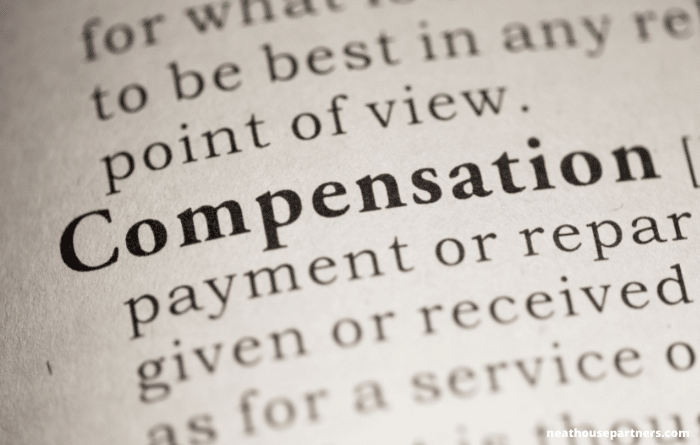Redundancy Consultation Meeting - What Employers & Employees Need To Know
A redundancy consultation meeting is an opportunity for an employee to discuss the terms and specific details about a possible redundancy.
James Rowland
Commercial Director James leads Account Management, Sales and Marketing at Neathouse Partners.Date
11 September 2021Updated
08 April 2024
Table of contents
Related articles
Tags

A redundancy consultation meeting is an opportunity for an employee to discuss the terms and specific details about a possible redundancy that may affect them when their employer has indicated that they need to reduce the size of their workforce.
Every employee at risk of redundancy has the right to a redundancy consultation meeting and this meeting should form part of the consultation period offered by employers to all employees at risk of redundancy, and this should be held before any redundancies are made.
What Does Redundancy Consultation Cover?
Redundancy consultation is likely to be held over several meeting dates and will allow for discussions to be held between the employer and the employee, or sometimes via a third party, to discuss everything that needs to be shared regarding the proposed redundancy.
This consultation time is intended to give the employee the opportunity to speak about why they’re being made redundant, find out more about the process and outcomes involved, and to discuss ways that redundancy may be avoided. Redundancy consultation meetings are managed on either an individual or collective consultation basis depending on the number of people at risk of redundancy in the organisation.
During consultation, meetings are held between the employer and the employee(s) or via a third party if more than 20 people are involved. They allow for discussion surrounding topics relating to the redundancy decision such as; why the employee has been selected, the opportunity to propose and discuss any alternatives to redundancy, and provide a forum for dispute resolution procedures if required.
Redundancy Rights

If a redundancy consultation meeting isn’t offered to an employee, then that redundancy may be classed as unfair dismissal and the affected employee(s) could take their employer to an employment tribunal.
In 2020, redundancies soared to a record high in the UK as a result in the drastic impact that the COVID-19 pandemic had on businesses. The Office For National Statistics indicated that redundancies rose to 370,000 between July-September - which is the most since records began in 1992!
In the case of 2020, many of these redundancies were made as a direct result of employers having to cut jobs just to keep the business going in such unprecedented times, but there are plenty of other reasons why employees may find themselves at risk of redundancy.
As an employee, it’s therefore important to know what to expect from a redundancy consultation meeting if you find yourself at risk of redundancy, and if you are an employer, you should know your responsibilities on how to handle redundancies respectfully and inline with employment law.
If you need advice on managing redundancy at your business, our expert team is here to help. Contact us today for advice on HR and employment law
Read on to find out more about the consultation meeting including, what happens in the meeting, how to prepare, and where to get support as either an employee or an employer regarding all things redundancy.
What Is Redundancy?
Redundancy is one form of dismissal from a job. Employers can make employees redundant when they need to reduce the size of their workforce for any reason, but one of the most important factors of the redundancy process is that any employee(s) being selected for redundancy, must be chosen fairly.
Right To Consultation

Once employees at risk of redundancy have been selected, there is a recognised redundancy process that employers should follow. As part of this, employees have the right to a consultation meeting with their employer.
The format of the consultations meetings, and number of meetings held between the employer and the employee will depend on how many people are being made redundant. This usually follows the formats outlined for either individual or collective redundancy later in this article.
If between 1 and 19 people are being made redundant, this is called ‘individual redundancy’ and employees will be spoken to on an individual basis and there are no rules regarding the length of consultancy period.
If however, 20 or more people are being made redundant within a 90 day period, then this is referred to as ‘collective redundancy’ and different consultation rules apply. This includes being spoken to collectively as a group via an employee representative and having a minimum period of time that the consultancy period cover. For example, if 20 to 99 redundancies are being made, the consultation must start at least 30 days before any dismissals take effect and If 100 or more redundancies are being made, then the consultation must start at least 45 days before any dismissals take effect.
Individual Consultancy
If only one person, or a handful of employees (up to 19) are facing redundancy, then the process usually starts with an informal meeting with all affected staff to advise them that redundancies need to be made and why. This is also usually when employers share details of how staff at risk of redundancy will be identified.
Following this announcement, individual members of staff identified as being at risk of redundancy are invited to discuss the situation 1:1 in more detail at a series of redundancy consultation meetings.
Employers should not assume the outcome of the consultation meetings will automatically be redundancy for the individual in question. The consultation should give the employee the chance to make any suggestions that they have on how to avoid redundancies and their input should be fully considered and responded to by the employer.
What Happens In The Meeting?

Common suggestions for avoiding redundancy include, changing hours, changing where or how often the employee works, changing from a PAYE employee to a contractor relationship, or taking up retraining opportunities for example. The employer should give full and serious consideration to any suggestions the employee makes and respond to them formally either in writing or at a second redundancy consultation meeting.
In addition, the employer should give the employee an opportunity to raise any objections they may have regarding the basis of their provisional selection and discuss whether there is any other alternative employment available in the organisation for the employee in question.
Finally, the consultation meeting should also include communications regarding what the employee can expect should their proposed redundancy be confirmed including;
- any financial severance packages available
- If paid time off to search for new employment is proposed
- how any outstanding annual leave will be managed
- how the notice period will operate
The individual consultancy process doesn’t specify a specific number of meetings that must be held, but it usually consists of at least two. This is so that any points discussed in the first meeting, and any feedback provided by the employee can be reviewed and formally responded to at a second meeting as well as tying up any new issues that arise during the consultation period.
Collective Consultancy
A collective consultancy procedure must be followed when 20 or more staff are at risk of being made redundant within a 90 day period. In this redundancy scenario, the employee must consult with the trade union or an elected employee representative before anyone else is given notice of redundancy.
Aside from the number of people involved, the main difference between individual and collective consultancy is that employers have to consult with a staff representative on behalf of the employees at risk of redundancy. This is in contract to consulting with each employee individually as seen in the case of individual consultancy.
There are where individuals involved in collective consultancy may need to be consulted individually though, and this should be facilitated by the employer.
Collective redundancy consultation meetings should be conducted with a suitable nominated representative. If the workplace has a recognised trade union, then consultation must take place with them. If no trade union is in place, then the representative liaising on behalf of the collective employees at risk of redundancy can be any employee representative. This person could also be a third party experienced in redundancy consultation if nominated by staff.
Collective consultation must take place over 30 days for between 20-99 job losses or over 45 days for 100 or more job losses. Employers must provide the representative with a specified list of information in advance of consultation meetings.
Any breach of these requirements can lead to employment tribunal claims, including a claim for a protective award of up to 90 days’ pay. This means it’s especially important for employers to seek specialist, professional advice when initiating collective redundancy proceedings at their organisation.
The points that should be covered during collective consultation period are the same as those for individual consultancy:
- Opportunities to avoid redundancy
- Opportunities to reduce the number of people made redundant
- Consideration of alternative working days and hours
- Job sharing options
- Whether re-training an option to keep roles
What Happens If No Consultation Meeting Is Offered?
If an employer fails to consult their employees regarding redundancy before making them redundant then the employer is leaving themself open to an employment tribunal being brought against them.
There is protection within redundancy proceedings that mean employees have additional protection to ensure they are fairly compensated should their employer fail to consult them properly. This is known as a protective award.
A protective award is an award of compensation payable to employees when:
- 20 or more employees are made redundant and the employer fails to inform and engage them in consultation regarding those redundancies
- When employees are transferred from one company to another under TUPE regulations and the employer fails to properly inform and engage them in consultation about that transfer.
If the employer breaches their legal duty to consult with their employees in either of the scenarios above then they will be in breach of this duty and an employee could bring a claim against them at an employment tribunal which is likely to result in them having to pay compensation to their employees in line with the amounts outlined by the protective award.
What Does The Protective Award Do?

If an employee is covered by a Protective Award then they must be paid by the employer their normal pay for each week of the protected period when they would usually have been expected to work, regardless of whether they are still working during this time or not. The protective period can be up to 90 days in collective redundancy cases or 13 weeks pay for transfers of employment.
There is no minimum length of service required for an employee to bring a Protective Award claim against their employer, but this must be started within 3 months from the date of dismissal (for collective redundancy situations) or the date of the TUPE transfer occurred.
When redundancy occurs due to employer insolvency, the protective award still applies. In this case the government’s insolvency service could pay the Protective Award due to employees but this will only cover up to a maximum of 8 weeks pay and will be capped at £544 per week.
If an employee is absent for predetermined contractual arrangements such sickness, maternity leave or parental leave they will still be entitled to Protective Award payment. If however, an employee gives up their job or is fairly dismissed for any other reason other than redundancy during the protective period, then they will forfeit their right to Protective Award compensation for the remainder of the protective period.
Expected Redundancy Meeting Procedure
It’s important that both employers and employees engaging in redundancy consultations act professionally and fairly throughout.
It’s therefore a good idea to keep detailed notes outlining any meetings held with minutes taken to show what was discussed and agreed between all parties. These should be signed and agreed by everyone present.
Employees engaging in these meetings may also be able to bring somebody with them to meetings with their employer. This is commonly someone from a union, HR, or another colleague. This can be helpful if the employee at risk of redundancy needs assistance in taking notes or would benefit from the support of a friendly face in what can be an incredibly daunting environment. Employers should treat requests for meeting accompaniment fairly.
The timeline for the consultation meetings to be completed will depend on how many people are at risk of redundancy, therefore how many different questions and opinions need to be heard and/or discussed. This will impact the number of meetings that need to take place but it should take place at least 30 days before the redundancies are due to begin or 90 days if more than 100 employees are affected.
Related Questions
Why Are People Made Redundant?
Redundancy is a form of dismissal used by employers when they need to reduce the size of their workforce, but the reasons behind this can vary.
If you are an employer that needs to let staff go, or if you are an employee that has been made redundant, or are facing redundancy, then it’s likely that one of the following factors has come to light.
- New technology means your job is no longer needed
- The job you were hired for no longer exists
- The company is having financial difficulties and needs to reduce overheads
- The company is closing down or moving to new premises
- The company is merging with another
- The business is going through a restructure or re-allocation of work
Is Redundancy Unfair Dismissal?

Although redundancy is a form of employee dismissal, it is unlikely to be unfair unless employers do not select the employees at risk of redundancy fairly, if they don’t follow the required notice and consultation period, or if they fail to pay their employees in line with redundancy regulations.
Redundancy is a fair reason for dismissal if the employer has a valid reason for making the redundancies, for selecting those at risk of redundancy and has followed a full and fair procedure to complete the redundancy process.
With this in mind, employees cannot be selected for redundancy based on any number of protective characteristics such as; sex, gender reassignment, marital status, sexual orientation, race, disability, religion or belief, age, maternity birth or pregnancy, parental responsibilities.
Workers should also not be selected for redundancy based on their membership or non membership to a trade union, their working pattern (e.g. full or part time), because they have exercised their statutory rights, whistle bellowing, or taking part in lawful industrial action.
Employers should therefore use a fair and objective way of selecting employees at risk of redundancy that can be supported by evidence.
Who Can Help Me?
Being made redundant can be a traumatic experience for employees, especially if it comes out of the blue. Equally, employers having to make redundancies will face incredibly challenging decisions that impact the lives of others and the running of their business.
Whichever side of redundancy proceedings you’re on, it’s natural therefore to have lots of questions or concerns regarding the process and correct procedure to follow.
If you would benefit from impartial and reliable advice about redundancy matters, you can contract the following organisation;
- Citizens advice
- A lawyer specialising in employment law
- Employers can utilise the services of external HR consultants like Neathouse Partners
- Your Trade Union if you are a member
Employers in need of professional HR support during times of redundancy should consider outsourcing their needs to handle the complexities of individual or collective redundancies.
Neathouse Partners offers fully outsourced HR services based on simple fixed-fees, giving you full control over your HR and can effortlessly guide you through the process of redundancy consultation meetings to ensure all legal obligations are met and that employees are treated fairly.
If you need advice on managing redundancy at your business, our expert team is here to help. Contact us today for advice on HR and employment law
Related blog posts

Redundancy Guide for Employers

Alternatives to redundancy: helpful tips for employers

An Employers Guide To Redundancy
Have questions?
Get in touch today
Contact us, and our team will get back to you within 24 hours. We value your questions and are committed to getting them answered quickly.


Hello! I am Nicky
Just fill in the form below with your details, and I will arrange for a member of our team to give you a call.
By clicking, you agree to our Privacy Policy





